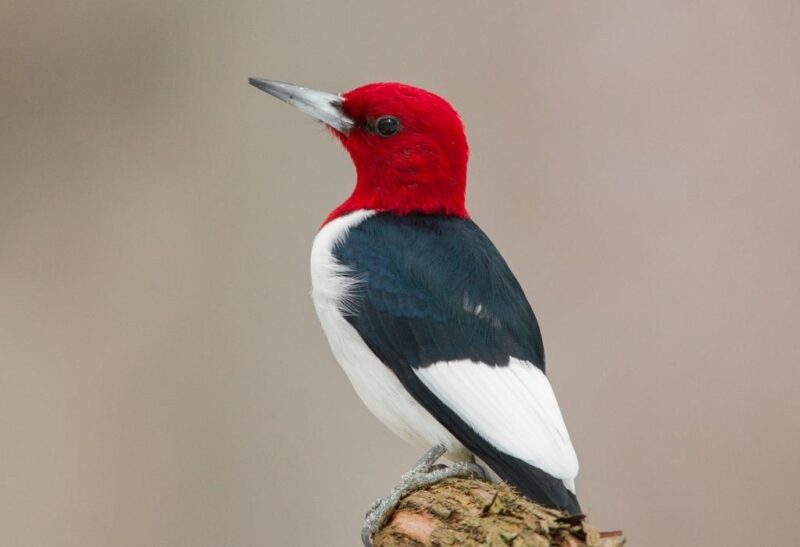Citing of over 270 bird species has happened for over 100 years in Colorado. In this state, the Rocky Mountain National Park is located in a ‘Global Important Bird Area.’
The Southern part of the park offers habitats for different bird species such as spruce, high elevation willow, aspen, fir, ponderosa pine, and alpine tundra. Thus, woodpeckers can also be found in Colorado.
What are the different woodpeckers in Colorado? The different woodpeckers in Colorado are Red-naped Sapsucker, Williamson’s Sapsucker, American Three-Toed woodpecker, Northern Flicker, Ladder-Backed woodpecker, Red-Headed woodpecker, Hairy woodpecker, Downy woodpecker, Red-Bellied woodpecker, and Acorn woodpecker.
You have to know more than the birds’ names. Their appearance embodies their identification. Let this article guide you to distinguish between woodpeckers found in Colorado.
Table of Contents
Are Woodpeckers Common in Colorado?
Woodpeckers are common in Colorado. They even cause damage to houses.
These birds create holes in wooden and synthetic eaves and stucco siding. Furthermore, the drumming and hammering noises annoy homeowners.
10 Woodpeckers in Colorado
Red-Naped Sapsucker

The wide distribution of Red-naped Sapsuckers in North America is due to the existing deciduous woody forests on the continent. They are short-distance migrants.
They begin building feeding territories in March, specifically in their pinyon-juniper habitats in Colorado. They would move to a higher elevation in the following month because of the breeding period.
- Scientific Name: Sphyrapicus nuchalis
- Appearance: This medium-sized body of this bird is black and white, but it has something like a red cap on its head. Its throat and nape are also red.
- Color: Black, white, red
- Beak Length: The length of its stout, sharp, and pointed beak is unknown.
- Lifespan: Up to 6 years
- Size: 7.5” to 8.5”
- Weight: 39 to 68 grams
- Diet: Insects, sap, or plant fluids
- Place of Origin: North America
- Characteristics: Territorial; motile; migratory; diurnal
Williamson’s Sapsucker
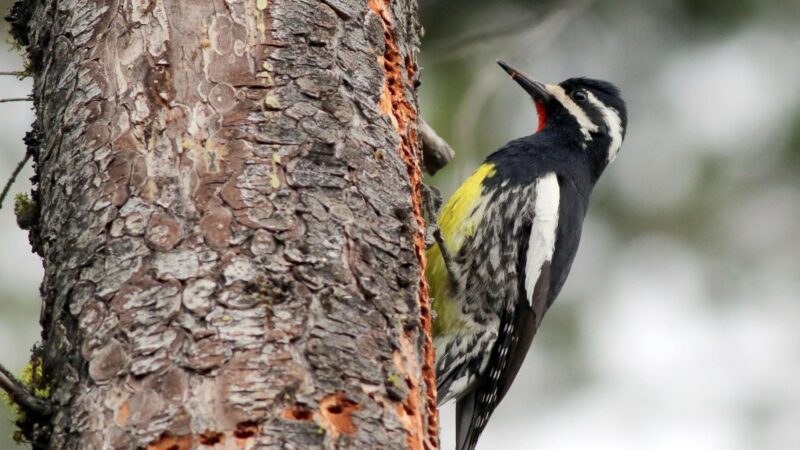
This bird spends time climbing vertical parts of trees. When parenting, it takes a nap by clinging to the tree for about less than an hour.
It loves sunbathing as it holds its head back and spreads tail feathers while the crown feather raises.
- Scientific Name: Sphyrapicus thyroideus
- Appearance: Males and females have different colorations. The males have black bodies with bright red, white, and yellow colors. On the other hand, females have a cryptic brown hue and yellow belly.
- Color: Bright red, white, yellow, cryptic brown
- Beak Length: Medium-sized
- Lifespan: 6 to 8 years
- Size: 21 to 23 cm
- Weight: 44.4 to 55.3 grams
- Diet: Sap, wood ants, insects like aphids, beetles, and flies, fruits and vegetables
- Place of Origin: North America
- Characteristics: Migratory; undulating flight; does sunbathing; territorial
American Three-Toed Woodpecker
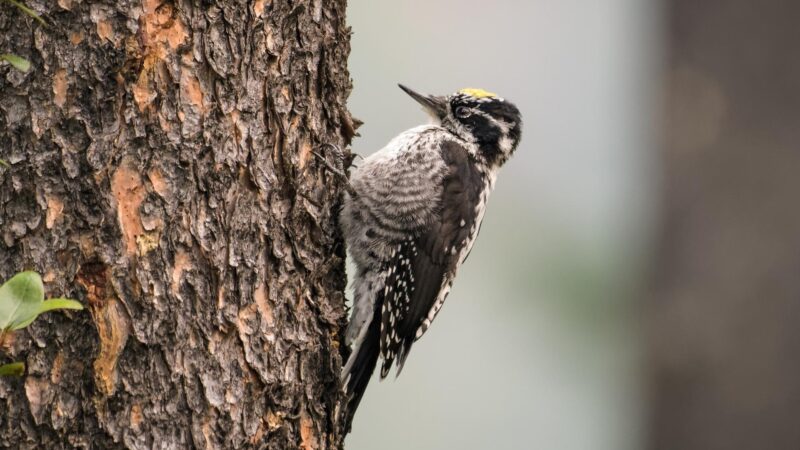
The drumming of American Three-toed woodpeckers can be heard from spring until early summer. They forage by scaling and flaking the bark. Before moving to another, they work hard first on a single tree.
- Scientific Name: Picoides dorsalis
- Appearance: This woodpecker has a black back and white breasts. Its barred backs and flanks are also a combination of black and white. The male ones have a yellow crown. There are white speckles on its forehead.
- Color: Black, white, yellow
- Beak Length: Chisel-like
- Lifespan: Unknown
- Size: Up to 20 cm
- Weight: 54 to 75 grams
- Diet: Sap, some fruits, insects like bark beetles and their larvae
- Place of Origin: Palearctic region
- Characteristics: Sedentary; solitary; territorial; motile; diurnal
Northern Flicker
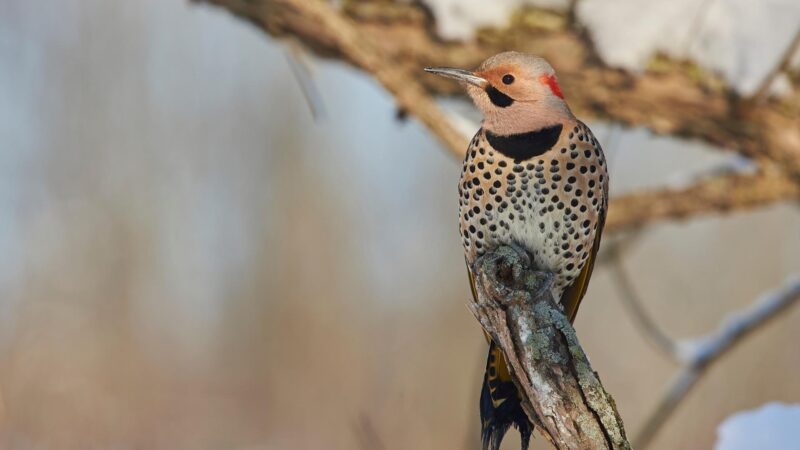
This woodpecker is unique from other species because it doesn’t act like one. It forages on the ground with the blackbirds and sparrows. During the mating period, rivals participate in a fencing duel using their beaks.
- Scientific Name: Colaptes auratus
- Appearance: Aside from its behavior, it’s also unique due to its appearance. This is the only woodpecker with a white rump and gray or brown barred back.
- Color: Gray-brown, tan, white, red
- Beak length: 4.2 cm
- Lifespan: Up to 9 years
- Size: 30 to 35 cm
- Weight: Around 420 grams
- Diet: Grains, nuts, seeds, fruit, terrestrial non-insect arthropods, and insects
- Place of Origin: Nearctic region
- Characteristics: Social; territorial; motile; migratory; diurnal
Ladder-Backed Woodpecker
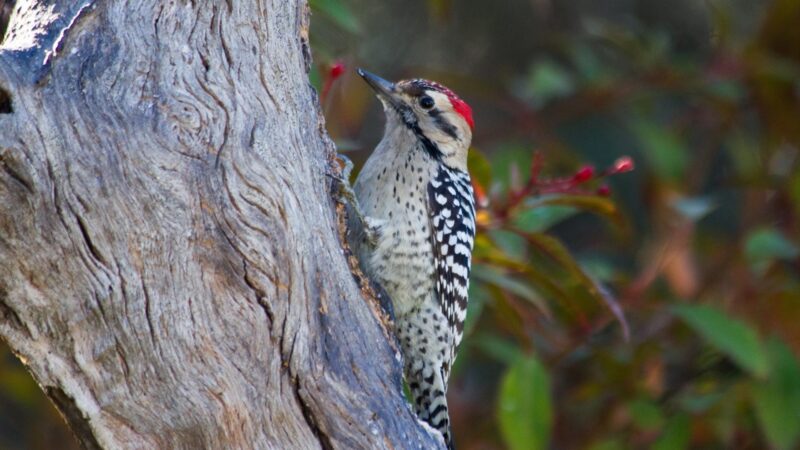
You’ll see this species in a swift and undulating flight. It can also climb, walk, and hop. This bird can be found in various habitats.
- Scientific Name: Picoides scalaris
- Appearance: This species looks similar to Nuttall’s woodpecker, but it has a black forehead, back, and wings. There are white spots and bars too. The males have a red crown patch.
- Color: Red, white, black
- Beak Length: Unknown
- Lifespan: Up to 4.5 years
- Size: 16 to 18 cm
- Weight: 21 to 48 grams
- Diet: Arthropods, insects
- Place of Origin: Nearctic region
- Characteristics: Visual; acoustic; chemical; tactical; sedentary; territorial; motile
Red-Headed Woodpecker
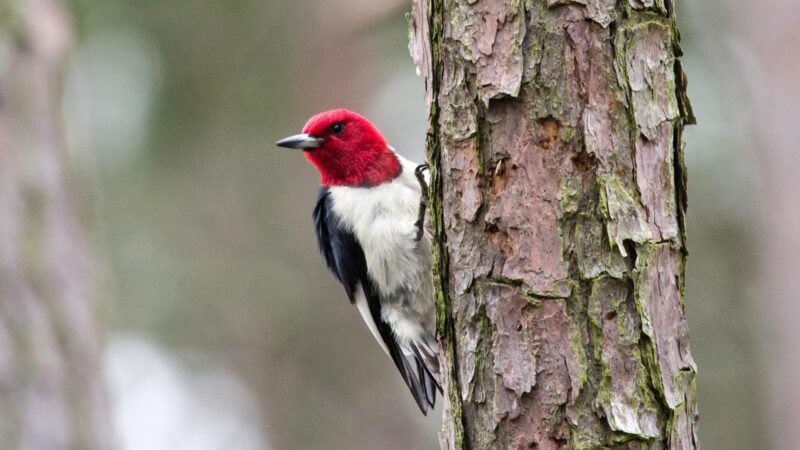
This is relatively smaller than other species. It’s difficult to determine its gender as both males and females do look.
- Scientific Name: Melanerpes erythrocephalus
- Appearance: Just as its name implies, this bird has a redhead, throat, and neck. The wings and tail are bluish-black and white parts. The white parts are obvious when this bird is in flight.
- Color: Bright red, bluish-black, white
- Beak Length: 12 cm long and chiseled-shaped
- Lifespan: 9 to 12 years
- Size: 21 to 25 cm
- Weight: 70 to 75 grams
- Diet: Stems, wood or bark, grains, seed, nuts, fruits, mammals, eggs, birds, terrestrial worms and arthropods, and insects
- Place of Origin: Nearctic region
- Characteristics: Motile; sedentary; caches or stores food; migratory; territorial; solitary
Hairy Woodpecker

You will likely see this woodpecker in forests, especially those with dead trees. To show aggression, it engages with bill directing and tail spreading when it becomes submissive.
- Scientific Name: Picoides villosus
- Appearance: The black and white checkered and streaks are noticeable on this bird. Moreover, the head, crown, neck, and eye mask are black. You won’t see a red patch on females.
- Color: Black, white, red
- Beak length: 3.4 cm
- Lifespan: Up to 15 years
- Size: 16.5 to 26.7 cm
- Weight: 84.5 to 85.5 grams
- Diet: Insects and larvae
- Place of Origin: Nearctic region
- Characteristics: Acoustic; visual; chemical; tactile
Downy Woodpecker
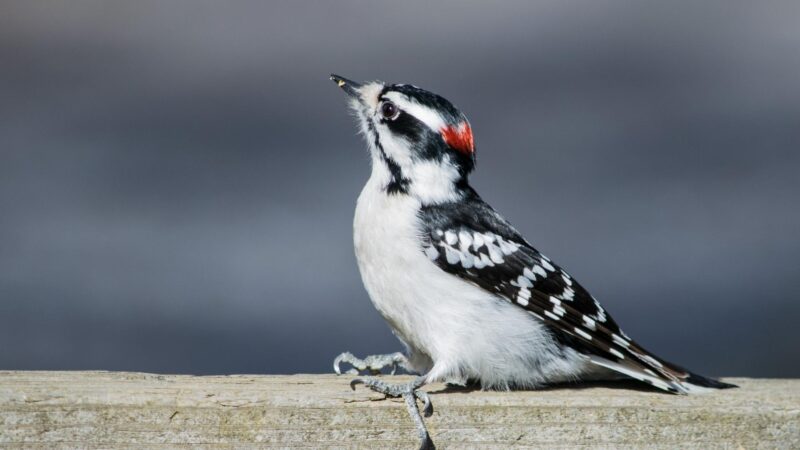
This is the smallest species of woodpecker native to North America. It may look like a hairy woodpecker, but it’s larger with a shorter and stubbier bill.
- Scientific Name: Picoides pubescens
- Appearance: Most of the body parts of this bird are white and black. The belly and chest can be white or grayish. You can identify the males through the red patch on their napes.
- Color: Black, white, red, grayish
- Beak Length: The beak length is from its eyes to the front of its head.
- Lifespan: Up to 11 years
- Size: 14.5 to 17 cm
- Weight: 21 to 28 grams
- Diet: Insects, terrestrial arthropods, fruits, seeds, grains, nuts, stem, bark or wood, sap or other plant fluids
- Place of Origin: Nearctic region
- Characteristics: Solitary; sedentary; non-migratory; diurnal; territorial; motile
Red-Bellied Woodpecker
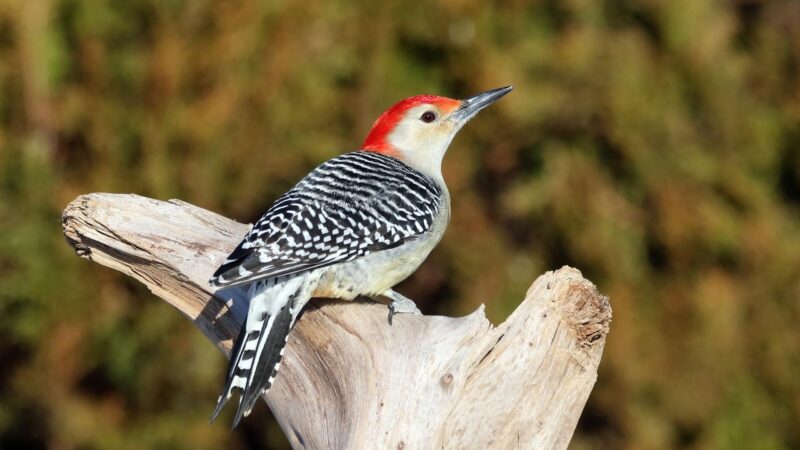
Red-bellied woodpeckers are not into migration, but they move to the South when winter comes. They can walk, hop, and climb. In addition, they have a special movement called ‘hitching.’ It’s when they amazingly hop upwards to the vertical section of the tree when searching for food.
- Scientific Name: Melanerpes carolinus
- Appearance: This is a medium-sized woodpecker known for its black and white zebra pattern on its back. The male has a red cap from the forehead to the neck’s nape, while the female only has it on her neck’s nape.
- Color: Red, black, white, gray
- Beak Length: 5.9 mm
- Lifespan: Up to 12 years
- Size: 22.9 to 26.7 cm
- Weight: Around 72.5 grams
- Diet: Amphibians, birds, fish, eggs, insects, non-insect arthropods, reptiles, grains, nuts, seeds, sap, or plant fluids
- Place of Origin: Nearctic region
- Characteristics: Scansorial; sedentary; motile; diurnal; territorial; solitary
Acorn Woodpecker
The sound that this bird makes is like laughter. White circles are displayed on its wings when it’s on a flight. When it flies, you can witness how it does a few flaps of its wings and then go a foot downwards.
- Scientific Name: Melanerpes formicivorus
- Appearance: This bird has a white and black head with a clown-like face. It has a red crown too.
- Color: Black, white, red, yellow
- Beak Length: Unknown measurement for its straight and spike-like beak
- Lifespan: Up to 9.5 years
- Size: Around 21 cm
- Weight: 73 to 85 grams
- Diet: Sap, flower nectar, fruits, insects, lizards, grass seeds
- Place of Origin: Nearctic and Neotropical regions
- Characteristics: Visual; chemical; tactile; acoustic
Frequently Asked Questions
Does It Mean Anything When You See a Woodpecker?
When you see a woodpecker, it means you are encouraged to go after new opportunities. The knocking and drumming that it makes tell you that you need to consider growing and expanding your vision. These actions remind you of optimism and creativity to develop yourself further.
Are There Red-Headed Woodpeckers in Colorado?
There are Red-headed woodpeckers in Colorado. You can find them all year round in the said state as they don’t migrate. They would only go to the southern area or lower elevation when it gets cold.
How Do You Get Rid of Woodpeckers in Colorado?
The most effective way to get rid of woodpeckers in Colorado is through physical exclusion. You can install bird-type netting on the outer eaves, as well as the building sides. It’s smart to choose the net color that is barely visible. You have to be particular with its tautness, as holes can develop.
You can also play distress and raptor calls to frighten woodpeckers. Models of hawks, owls, spinners, windsocks and other scary stuff can be used.
- Sounding like a crow is a perfect way to entice a springtime...
- You can then move closer and attempt to lure the gobbler into...
- Just as people have different voices, crows produce different...
- Super raspy, excellent turkey locator, great for calling crows
- Primos Hunting is the leader in the design and manufacturing of...
However, their effects on these birds are inconsistent. If you don’t have any other choice, you have to secure a depredation permit to get rid of them.
Is It Illegal to Shoot Woodpeckers
It’s illegal to shoot woodpeckers because these birds are protected by the Migratory Bird Treaty Act.
Are Woodpeckers Good to Have Around?
Woodpeckers are not good to have around as they can damage wooden parts of houses. They would likely drill the rotten wood of your house to make a nest.
Another reason for this kind of activity is that they search for a place to keep their food. Without any reason, some woodpeckers would bang on a surface that is not wood to amplify their drumming.
Summary
Woodpeckers are interesting birds. However, they can be a nuisance for some people as they can damage houses and unceasingly create annoying noises.
By knowing their identities, you can confirm if they’re the ones to blame for the damages. Still, you can’t just get rid of them any way you like. They’re protected as migratory birds, so it’s better to protect the exterior of your house from them.
List of Sources
Shaw, T. What to do when your house catches the attention of woodpeckers. U.S. Fish & Wildlife Service.
Andelt, W. F., Hopper, S. N., Cerato, M. (2014). Preventing Woodpecker Damage. Colorado State University Extension.
Vasquez, M. (2005). Red-naped Sapsucker (Sphyrapicus nuchalis). U.S. Department of Agriculture.
Dobbs, R. C., Martin, T. E., Conway, C. J. (1997). Williamson’s Sapsucker. The University of Arizona.
Three-Toed Woodpecker. (2018). National Park Service – U.S. Department of the Interior.
